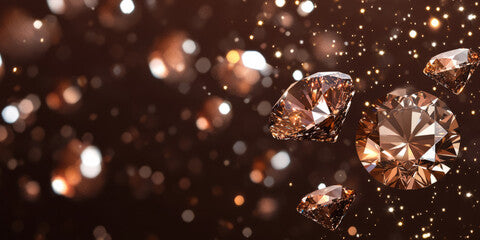When most people think of diamonds, they imagine the classic icy white sparkle. But in recent years, warm-toned brown diamonds—often marketed as “chocolate diamonds”—have taken the jewellery world by storm. For us at The Diamond Club in Joondalup, these gems are more than a trend—they’re an opportunity to craft stunning, distinctive pieces that tell a uniquely Australian story.
In this guide, we’ll explore whether chocolate diamonds are valuable, what influences their worth, and how we as manufacturing jewellers help clients select the perfect one.
1. What Are Chocolate Diamonds?
Chocolate diamonds are simply natural brown diamonds, coloured by structural changes in the crystal lattice. Their hues range from light champagne to deep cognac, and luxury jewellers often use appealing trade names like “Chocolate”, “Cognac”, or “Champagne” to market them.
While colourless diamonds have long dominated engagement rings, chocolate diamonds offer something rare in today’s market: a distinctive, earthy elegance.

Australia has played a huge role in bringing brown diamonds into fine jewellery. The Argyle mine in Western Australia—famous for its pink diamonds—also produced an abundance of high-quality brown stones.
In the 1980s, marketing transformed these previously undervalued stones into a desirable category. Now, with the Argyle mine closed, Australian-origin chocolate diamonds hold a nostalgic and provenance-driven appeal.
3. Are Chocolate Diamonds Valuable?
From a market perspective:
- Retail prices are generally lower than equivalent white diamonds, making them more accessible.
- Exceptional stones—deeply saturated in colour, with excellent cut and clarity—can command strong prices.
- Provenance adds value—Argyle-certified stones, particularly in richer tones, have collector appeal.
As jewellers, we see value not just in dollar terms but in design potential: chocolate diamonds offer luxury at a more approachable price point.
4. The 4Cs for Chocolate Diamond
When assessing value, the 4Cs still matter:
- Colour – Rich, evenly distributed tones (deep cognac or golden brown) are the most desirable.
- Cut – Precision cutting enhances brilliance and colour intensity.
- Carat – Larger stones show colour more vividly.
- Clarity – Slight inclusions are common but less noticeable against darker hues.

Pro Tip: Pairing a chocolate diamond with rose or yellow gold enhances its warmth.
5. Styling & Design Ideas from Our Workshop
At The Diamond Club, our clients love:
- White diamond halos around a chocolate diamond centre stone for contrast.
- Vintage-inspired settings in rose gold.
- Stacking bands with brown melee diamonds for subtle sparkle.
-
Custom Argyle collections featuring both pink and brown diamonds for a uniquely Australian look.
6. Resale & Investment Considerations
We’re always transparent with clients—chocolate diamonds are best purchased for beauty and wearability, not as speculative investments. While exceptional stones may hold or increase in value, most are not traded like rare fancy-coloured diamonds.
7. Caring for Chocolate Diamonds
These stones are just as durable as any diamond (Mohs hardness 10), so they’re perfect for everyday wear. For best results:
- Clean with warm soapy water and a soft brush.
- Have settings checked yearly by a jeweller.
-
Avoid harsh chemicals when cleaning.

8. Why Buy from a Manufacturing Jeweller?
Choosing The Diamond Club means you get:
- Direct sourcing from trusted suppliers.
- Custom design from sketch to finished ring.
- Australian provenance options for true local heritage.
- Better value—no middleman markups.

